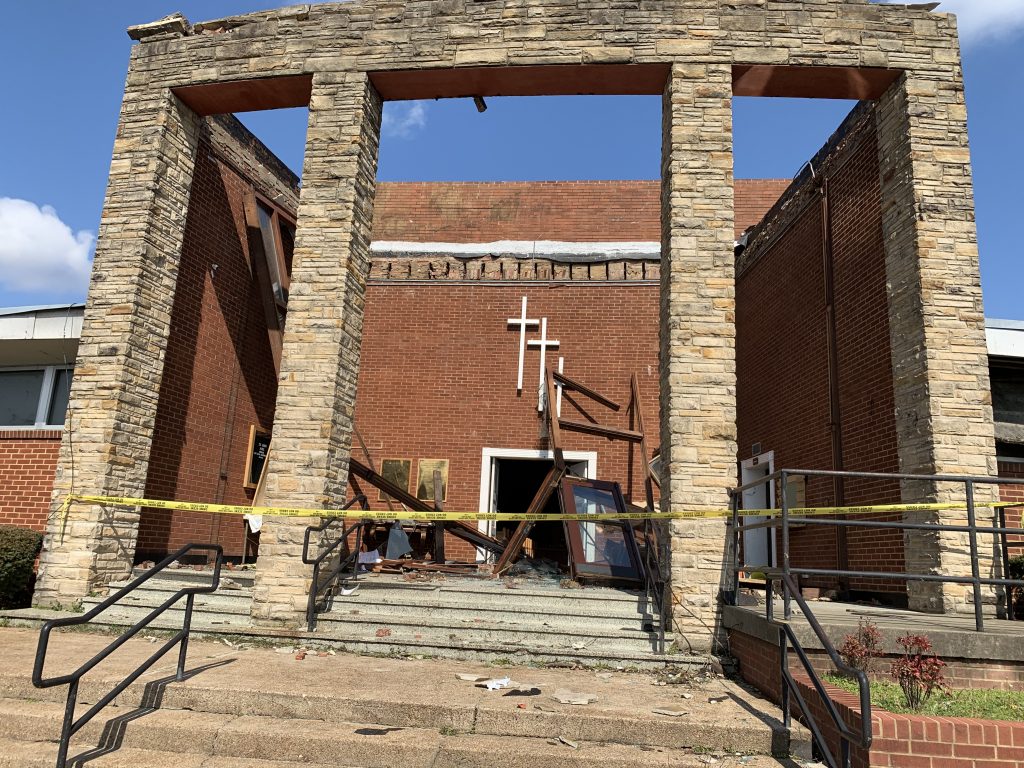Editors Note: Rev. Lisa Hammonds is pastor of St. John AME Church in North Nashville. We asked her to share her story of pastoring her congregation through the March 3 Nashville Tornados. If you would like to support the church in its clean up efforts, you can send a donation on Cash App ($StJohnAMENashville). Read part 2 of 2 here.
How to Survive a Tornado ~ Part I
At 12:10 AM on Tuesday morning, March 3, I randomly turned over in a half-sleep state and moments later heard my cell phone sound a weather alert. I changed the TV channel to the local news and learned of a tornado threatening Middle Tennessee and particularly Nashville. As I laid in the bed for a few minutes the wind and rain increased outside the window of my East Nashville home. Soon I heard the weather sirens warning residents to take cover.
I put on street clothes and grabbed my phone and fur baby and we headed for the downstairs bathroom, where I alternated watching the storm on my phone apps and local television news.
Fifteen minutes later when it seemed things were calming down outside, we emerged from the bathroom and headed back to bed. The media was now reporting devastating damage to June Tune Airport. I also heard reports of damage in Germantown, where my brother-in-love’s father and another colleague lived. The storm was still raging on toward Hermitage and Mt. Juliet. Although I was concerned about North Nashville on the other side of Rosa Parks, the absence of any coverage falsely allowed me to believe St. John, our neighbors, and the North Nashville community had been spared. I prayed and went back to bed around 12:40 AM.
I had just turned off the light when my phone rang. It was a neighbor of the church who informed me that the church had suffered “some damage” from the storm. I thought there were probably downed trees or a blown-out window. We established FaceTime; and because the power was out, they tried to shine their headlights on the side of the church.
I couldn’t see anything and asked them to move to the front of the church. The reply was the start of what would be a new dimension of my ministry, one I never could have fathomed or imagined. They simply said, “Pastor, you don’t have a front of the church.”
A Heap of Wood and Glass
My first visit to the church happened around 1:30 AM. I parked a block away because downed trees blocked 21st Avenue. I got out of the car and traversed downed power poles and lines, and branches in the pouring rain.
When I rounded the corner, I found that the front façade of our beloved church was, in fact, gone. What remained was a heap of wood and glass. I collapsed into the arms of that neighbor who called. They lovingly took me into their home, provided me with a towel, and we prayed.
I returned to the church at 6:00 AM with an AME Church colleague-mentor who refused to allow me to return alone after learning what happened. We parked in the same spot as several hours earlier. The neighborhood was now alive with people.
Neighbors were accessing damage with the first light of the day. As we approached the church, I saw blown out windows I couldn’t see earlier. Large trees, insulation, and siding from nearby homes littered the grounds.
Seeing the front of the church in the light didn’t compare with seeing it in the dark with rain. Posters from the bulletin board and programs from the previous Sunday’s worship service were mixed in with the splintered frames of the once- majestic doors. Walking around to the other side of the church, I also found damage to the St. John van that was extensive enough to be declared a total loss.
Caution Tape
I had a conference call with the stewards and trustees at 6:30 AM and the entire congregation at 7:00 AM. I made both calls while standing in the church’s parking lot littered with trees and debris. After taking pictures, and with the urging of my mentor, I left the scene to begin making calls to the insurance companies and others. The building could not be secured and I was not certain as to its structural integrity so I called the Fire Department. They put up caution tape prohibiting entrance.
I returned to the church at 11:30 AM, and volunteers were now in the streets with chain saws, clearing 21st Avenue. I parked directly in front of the church. A trustee and I entered the back of the building.
To stand in the sanctuary where I had preached just 48 hours before and look up to see the roof peeled back revealing a blue sky overwhelmed me, to say the least. Stained glass windows, salvaged from St. John’s first edifice in downtown Nashville, lay shattered across the rain-soaked and broken pews. Ceilings in the conference room and library had collapsed. In one hallway, water was falling from an unknown source in the ceiling. Despite the destruction all over the building, the altar, pulpit, and choir loft seemed untouched.
On that visit I also learned that several St. John members also sustained storm-related damage. Of the five members who reported damage, two live across the street on 21st Avenue. They experienced roof damage, broken out windows, and blown off siding. Even more members endured power outages in North Nashville. Some did not have power for a week following the tornado.

+++++
Part II of Pastor Lisa’s blog shares more of the story of how to survive a tornado when it hits your church building. Also, visit our stories about collaboration for the sake of tornado recovery in North Nashville — as it intersects with the pandemic and centuries of racism.





